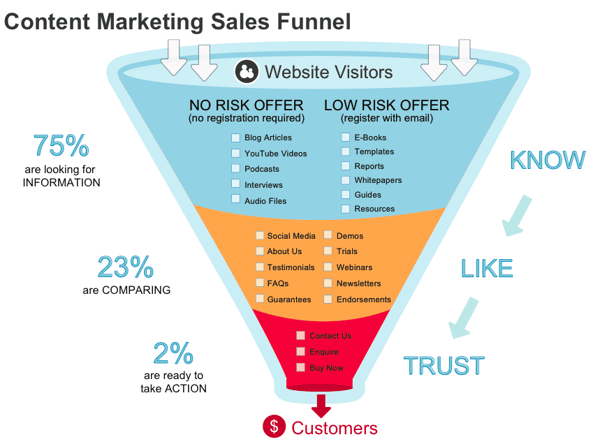Most digital agencies have, as one of their core tools in their armoury, content marketing.
They talk about content funnels, flywheels, marketing automation and SEO optimisation.
But what very few agencies talk about is, what is content, or what is the purpose of content?

(Image source: bid-masters.com)
The Content Marketing Funnel is a crucial tool in providing a roadmap of the type of content you should be providing to your visitors at each step of the funnel. But the funnel typically tells us the type of content we should be producing, rather than answering the what is and purpose questions of content.
Let’s take a look at a couple of examples.
The flywheel model:
The flywheel tells us that our content should attract visitors to our site, engage with them and then delight them. This will keep visitors returning. It is highlighting what the content should do, rather than what it is.

(Image source: hubspot.com)
When combined with the content funnel, the flywheel is helpful in providing a helicopter view of what type of content we should be creating, but no more.
Content automation:
Content automation is the delivery of content via various software services, with HubSpot being, one of the most well-known. Undoubtedly, automation is a great tool. It saves time and enables content to be delivered to the right person at the right time. An important part of the content marketing process, but still only a part of the process.
But still it does not get to the nub of what content is and its purpose.
Sometimes the actual content is the least important part of the overall strategy, with emphasis being placed instead on the type of content and delivery method. We are content deliverers, rather than content creators.
Is this putting the cart before the horse?
In today’s time limited, distraction-led world, let’s ask an honest question. Why would anyone want to read your content?
There is an unspoken agreement between the content creators and the potential reader.
Provide me with something of value in exchange for my time or my details – not just content for content’s sake. I don’t need more noise in my life.
There are acres of content that provide no actionable or helpful advice. Or perhaps even worse, content that is loosely dressed as providing value, but is really nothing more than self-promotion. Time spent that you cannot recover.
If you want to engage with your visitors and for them to return, then don’t’ waste their time by breaking the unspoken agreement.
There are plenty of different ways to build trust in your brand, but through the medium of content, it must be by providing value.
Content must inform, educate, excite, transport, communicate, persuade, provide an experience. It must satisfy desires and needs. It must differentiate. It should help to gain a greater percentage of mind share - enabling people to be confident in taking risks and standing out. Content is the mechanism that helps to communicate how problems can be solved, but it is not the delivery mechanism itself.
And it should not be reduced to one.
Above all, content must add value.
By far the better approach to content is to use the client-specific content funnel to decide on the type and purpose of content, obviously with the overall goal of engaging with your visitors and then ask yourselves - what are we providing that is going to honour the agreement?
Think more broadly, as content does not always have to be related specifically to your product, platform, service or solution, but it must be related to your potential customers.
An excellent way of building trust and brand awareness is by providing advice that you do not directly benefit from, but which provides value to your potential customers for where they are in their buying and decision-making journey.
It might be providing an article that enables them to improve, enhance, develop or expand what they are doing now. And by that, we don’t mean an article which lists all the varied reasons why buying your product will help them to do that.
Rather, an article that understands some potential customers might not be ready to buy now, but which will nevertheless enrich what they are or can do in the meantime.
Every content piece should be examined, and the question asked - does it honour the agreement to our readers?
If it doesn’t, then save your own time and energy and don’t write it.








